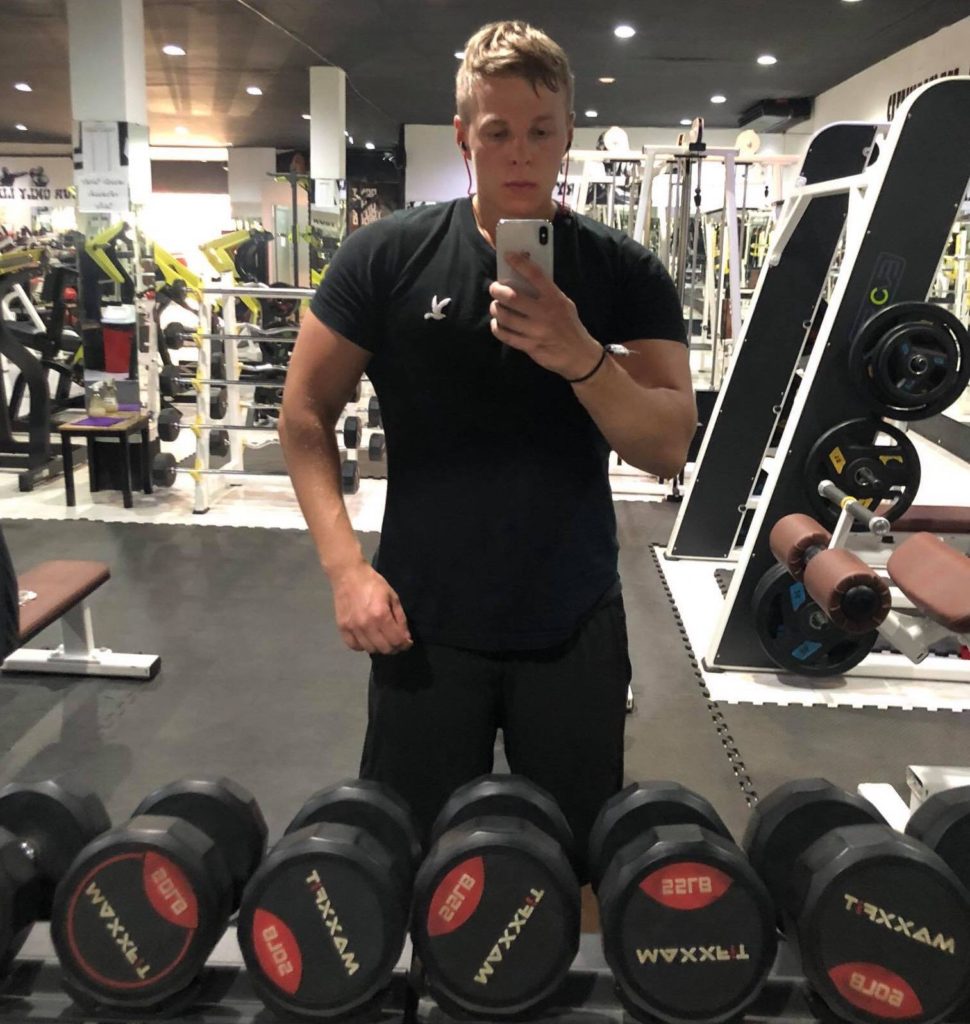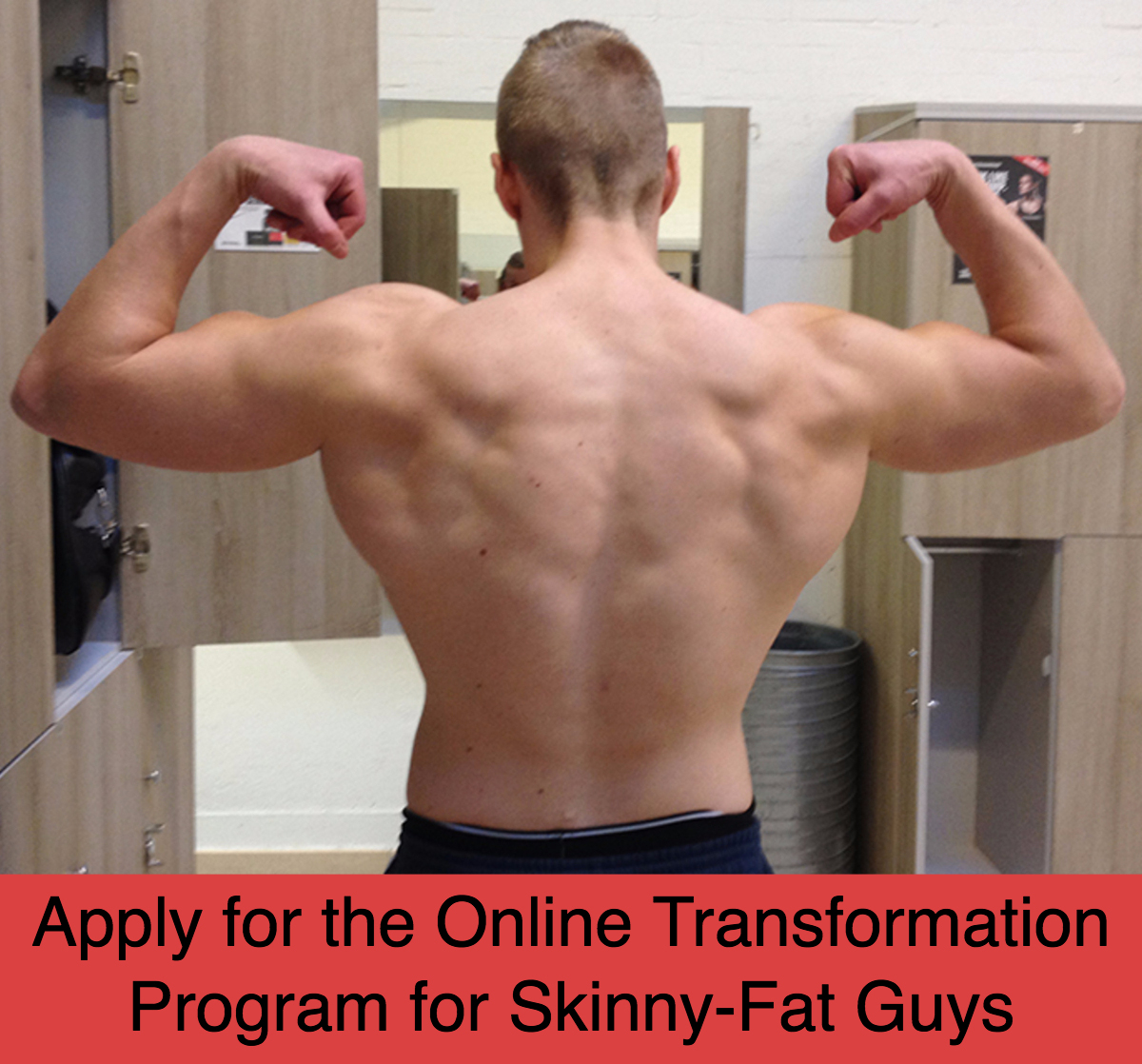 (1) Start easy, but over the long-term, don’t worry about overtraining
(1) Start easy, but over the long-term, don’t worry about overtraining
Most skinny-fat guys start training too hard.
A good example is that you start doing heavy weights 3 times per week when you can’t even do a full ass to grass squat with proper form or a single pull up, and on top of that you add hours of jogging too.
The result? Excessive soreness followed by an injury or burnout.
The truth is that someone with below average fitness levels doesn’t need to begin with going hard.
Instead, you need to go smart and use exercises that target the important areas of your body while minimizing risk of injury.
For this I recommend you focus on chin ups, diamond push ups and bodyweight squats.
These target the lats, arms, shoulders and upper chest so you can build a V-tapered upper body with powerful arms while keeping the legs conditioned, mobile and in proportion.
It’s important that you go in consistently everyday and stimulate the whole body to grow, compared to going hard a few times per week.
This is one of the reasons to why bodyweight exercises are so ideal for skinny-fat guys. They can be done anywhere at anytime.
Chin ups, push ups and squats are all you need to begin with to see results.
(2) Once you build that base, don’t worry about overtraining
Once you have a decent base and you can do 15-20 chin ups with good form, 20-30 diamond push ups and 100 squats, you can start to go harder.
This is the time you can amp up the exercise and do high volume, high frequency training.
Your body can get used to pretty much anything as long as you build up gradually, therefore don’t limit yourself to the old dogma of doing 10-20 sets per body part per week and training 3-4 times per week.
You wanna take the opposite approach of everyone else: Start with just enough daily exercise to stimulate the body and build up gradually.
At the beginning, your body doesn’t need much exercise to respond.
When you master the form on an exercise and you can do clean sets with reps, don’t be afraid to push it hard.
(3) Focus on exercises where you move your body through space
Every skinny-fat guy wonders why their lower body blows up on 5×5 programs where they do heavy squats and deadlifts while their upper body stays the same?
The answer is simple: Squats and deadlifts move the body through space.
Bench presses and rows move a weight through space.
In my experience, exercises that move the body through space produce a much superior training effect compared to exercises that move a weight through space.
This is especially the case for a hardgainer who naturally doesn’t respond well to training.
This is why all heavy barbell programs lead to a bulky lower body combined with minimal gains on the upper body for all skinny-fat guys that try them.
So what’s the solution?
If you want the lower body gains, then keep the squats and deadlifts, but switch out the rows and presses for variations of chin ups, push ups and dips.
When these exercises get too easy, you can always add weight to them through a weight belt.
I have my clients work their way up to first doing 15-20 chin ups and 20-30 diamond push ups followed by working their way up to 5 reps with 100-130 pounds attached on weighted chin ups and dips.
I’ve seen that weighted chin ups and dips lead to great muscle gains for every single skinny-fat guy who trains them consistently while in a Caloric surplus.
With presses and rows, it’s hit or miss. Some people respond while others don’t and the response is rarely as strong as for the chin ups and dips.
(4) Don’t be afraid of starting with easier variations of bodyweight exercises
If you can’t do reps of full range of motion pull ups, start with just hanging on the bar.
When you’re comfortable hanging for a minute, work on inverted rows and negative part of pull ups.
Then later get into real pull ups.
The same principle applies to other exercises.
Don’t be afraid to do easier variations such as wall push ups and hanging on a bar until you get strong enough.
The #1 reason skinny-fat guys don’t master bodyweight exercises is because we suck at them.
We don’t want to go into the gym and work wall push ups or fail at pull ups because it’s a big hit to our ego.
As a result, we load up the machine or barbell and try to go heavy with crappy form.
This always leads to 0 muscle gains and injuries.
When you train with bodyweight exercises, don’t let your ego get the best of you and stop caring of what other people think.
Start with a variation of each exercise that you can do with at least 6 reps with perfect form then build up gradually from there.
We’re all starting somewhere and training to improve ourselves. No one will look badly at you for trying.
(5) Don’t limit yourself to training a typical fitness program where you do one or two body-parts per day

Train the whole body 6 days per week.
It’s better to do a little everyday but consistently.
As a drug free trainee, you can’t do a ton of QUALITY sets and reps in each workout to begin with because you fatigue fast and your form starts to slip.
This is why spreading it out over the week is better.
By training the whole body daily, you can get in more quality sets for each body-part, and that leads to much faster improvements in strength, technique and muscularity.
I’ve trained this way for nearly 8 years and my body has never been close to reaching a state of overtraining.
Also, vary the rep ranges.
For optimal growth I recommend you train with anywhere from 6-30 reps per set. (Read why in my article “Low Loads and High Loads Result In Similar Levels of Hypertrophy”).
(6) Listen to your body
Any time you feel any type of joint pain during a movement (especially sharp pain) you have to stop immediately and figure out why you get it and how to fix it before you proceed.
Never push through pain since that will inevitably lead to major injuries that set your training back for months or even years.
Once you get a debilitating injury, it will always set you back in your training and limit the amount of gains you can make over a life time.
For example, if you injure your shoulder, your upper body training will always be limited by that injury.
If you injure your knee, your lower body will always be limited by that injury.
This is why avoiding injuries is one of the most important things to ensure long-term progression.
Simply by avoiding injuries, you’ll ensure that you can go in year after year and become a better version of yourself instead of being in these cycles where you make some gains followed by time off to let your injury heal.
Sometimes, the movement just isn’t suited for your body-type and you will be able to do other variations of the same movement pain free. Other times, it’s overuse or bad technique
Regardless of what it is you have to figure it out instead of pushing through.
(7) There are no essential exercises everyone must do (e.g. deadlifts, squats, bench presses).
Even though I recommend exercises where you move your body through space, sometimes it just isn’t possible.
For example, while the weighted dip is an incredible mass builder for the chest, shoulders and triceps, it just isn’t suited for everyone.
I’ve had many clients who simply can’t do dips no matter how hard they try because they get shoulder or sternum pain.
In this case, using an alternative exercise is the better choice.
Perhaps in the future once you have more strength and mobility you will be able to do exercises that previously caused pain and discomfort.
Remember, there are many exercises for every muscle group in the body and while some exercises are high risk and high reward, you can still make progress with the lower risk and lower reward exercises as long as you structure your program properly.
Here’s a list of low risk but moderate-high reward exercises for each body part:
- Back: Pull ups, chin ups, cable rows and lat pulldowns.
- Chest: Diamond push ups, push ups, low cable flyes, DB incline presses, DB incline flyes, DB incline pullovers.
- Shoulders: DB front raises, DB lateral raises, DB reverse flyes, reverse pec deck flyes, reverse cable flyes, dumbbell presses.
- Biceps: Biceps bodyweight rows, cable curls, reverse grip cable curls, superman cable curls.
- Triceps: Cable pushdowns, cable triceps kickbacks.
- Legs: Leg presses, leg extensions, hamstring curls.
These are in my experience of training 10 years completely injury free the safest exercises to do for each body part.
I’ve been able to hammer all these with high volume and high frequency and never felt any joint discomfort.
Most of my programs are usually based around these.
If you look at the exercises, you’ll spot a trend: I’m very fond of bodyweight exercises and cable exercises and to some extent also dumbbells.
I mostly avoid barbells and machines.
I use bodyweight exercises first in my workout to hit all the important muscles, then finish off with lots of cable and dumbbell isolation work.
Why cables and dumbbells? Because you can move a resistance more naturally with these compared to a barbell or machine where the resistance is more fixed.
This leads to less stress on the joints and thereby much faster training recovery.
You can go in and hammer your upper body hard with bodyweight work and cables every single day and recovery easily and make amazing gains.
To finish off here’s a list of higher risk exercises:
- Back: Bent over rows, deadlifts.
- Chest: Dips, various chest machines that don’t fit your body structure, barbell presses (especially flat).
- Shoulders: Upright rows, barbell presses, shoulder press machines.
- Biceps: Barbell curls.
- Triceps: Skullcrushers and overhead extensions.
- Legs: Barbell squats, deadlifts, lunges,
I also include higher risk exercises in my training but I’m always extra careful with technique and usually do them deeper into my workout when my whole body is warm.
(8) Don’t underestimate the power of high quality sleep
Endless studies have shown that individuals who sleep sufficient quality hours (typically 7-9 hours per day) gain more muscle mass and lose more fat on a training program.
Here are the benefits of sleep outlined:
- Improves your testosterone levels and nutrient partitioning which means that any excess Calories are more likely to be used for building muscle mass rather than being stored as fat.
- Speeds up recovery so you can train longer, harder and more often. This leads to more muscle gains over the long-term.
- Regulates the hunger and satiety hormones leptin and ghrelin which leads to less cravings for junkfood and decreases the risk of overeating.
- Increases energy levels and willpower. This improves the quality of your workouts and makes you more likely to stay consistent with your fitness lifestyle.
In other words, it greatly helps you reverse the skinny-fat look.
As a result, getting high quality sleep is one of the key things I help my skinny-fat clients with when we start the training.
Without proper sleep it’s unlikely that you’ll get to anywhere near your physique potential.
Here are some crucial tips to improve sleep:
- Avoid stimulants and caffeine after 2 PM.
- Avoid alcohol.
- Exercise daily to use up your energy but avoid working out right before bed time.
- Get outside in the morning without any sunglasses, even if it’s just for 10 minutes. This will help your circadian rhytm.
- Keep your bedroom dark, cool, clean and quiet.
- If you have any allergies or congestion make sure to treat them to improve your breathing during the night time.
- Get a pair of bluelight blocking glasses.
- Set an automatic daily reminder on your phone to get ready for bed 10 hours before you have to wake up. When this reminder goes off you stop any work, gaming or watching movies and get ready for bed. Also, put on your bluelight blocking glasses.
- If you wake up in the night time to pee, never use your phone and put on your bluelight blocking glasses immediately. This will make it easier to fall back asleep.
- If you are unable to sleep on time, I recommend you try having a low dose of melatonin for a few days. This can help reset your sleep cycle. If you take melatonin make sure you take no more than 2 MG, drink no alcohol and that you check if it interacts with any medicines you take.
- Use the app SnoreLab to check for snoring. If you snore it’s a great indicator of sleep apnea which is a very serious sleep condition that must be treated by a sleep doctor.
If you already do all this and still feel fatigue daily or have insomnia, I recommend you see a sleep doctor to dial in your sleep.
It can make a massive change in your hormonal production, willpower, recovery, energy levels and training results.
Be proud but stay hungry!
Oskar Faarkrog, ISSA Certified Trainer
 Read my free 50 page guide "The 2 Phases of a Skinny-Fat Transformation"
Read my free 50 page guide "The 2 Phases of a Skinny-Fat Transformation"